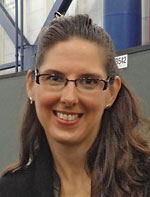The complex and confusing world of allergy testing can be made better by laboratorian-led standardization efforts, according to Kareena Schnabl, PhD, FCACB, a clinical biochemist in the department of laboratory medicine and pathology at Alberta Health Services and the University of Alberta Hospital in Edmonton, who spoke at the 2013 AACC Annual Meeting, along with Harissios Vliagoftis, MD, an associate professor and director of pulmonary medicine at the University of Alberta. Their presentation on the utilization and standardization of laboratory allergy testing was part of the quadrennial joint Annual Meeting of AACC and the Canadian Society of Clinical Chemists.
Schnabl described an extensive Alberta-wide overhaul of allergy testing practices and protocols, which the participants now plan to extend to all of Canada. If only allergists and immunologists ordered allergy tests, the initiative in Alberta might not have been necessary, she suggested. However primary care practitioners with less knowledge of the ins and outs of lab-based allergy tests are responsible for a sizable amount of this testing, owing to a shortage of specialists in Canada. As CLN has reported previously, there is confusion about this area of testing in the United States as well (CLN Dec 2010).
"We have a very dramatic shortage of allergists across all of Canada, so the load is resting on pediatricians and primary care doctors. Often, they don't get as much education in allergy testing as clinical allergists or immunologists, so when they get into this area it can be a real challenge," said Schnabl. "We frequently were getting calls from them, asking what test results meant. We also found that some of the testing was really inappropriate."

Kareena Schnabl, PhD, FCACB
Team Work and Communication
Concerned about less-than-optimal testing patterns, Schnabl spearheaded the standardization effort, which started with a multidisciplinary working group. In addition to a gap analysis comparing existing practices against guidelines, the working group contacted primary care physicians to learn what was confounding them about allergy testing.
The group also looked at test formularies and ordering practices and found that inconsistency was the name of the game. Considerable discussion focused on which tests to include on a proposed standard requisition form. In the end, the group decided to focus on tests for the top eight or so allergens responsible for about 90% of food allergies.
Another important step of the process was educating lab staff. "We needed something to guide them because we had so much confusion around lactose intolerance, celiac disease, and food allergies, and which test to order for each condition," said Schnabl. Other topics included explaining the differences among panel tests, screening tests, and tests for individual allergens, as well as maintaining a problem requisition folder for lab directors to review and resolve.
Schnabl personally tackled the thorny issue of referral testing and once again found a striking lack of consistency. This analysis eventually led to proposed new reporting comments to help primary care practitioners better interpret allergy test results.
While this successful improvement process was focused on allergy testing, it could be used for any type of diagnostic testing, according to Schnabl. "Communication was the problem initially, and it's what helped us solve the issue. Clinical immunologists and allergists knew these problems existed but they didn't have the time to deal with them or they needed help bringing all the parties together," she said. "After we started this project I learned a lot by speaking with primary care practitioners and other laboratorians and finding out what worked or didn't work for them. So our success came from taking those best practices and putting them all together."